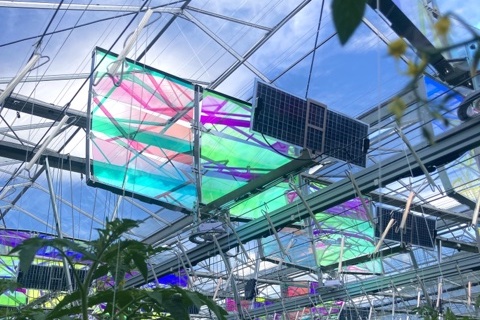4/1/2024
Solar Power in the Greenhouse
Jennifer Polanz

It’s not the first time we’ve written about new technology to capture solar energy and use it in the greenhouse, but this concept from Voltiris is unique in that it combines film-based products and solar cells to harvest energy.
I talked to Nicolas Weber, CEO and co-founder of Voltiris, a Switzerland-based company working with 3M to create a solar solution for greenhouse production. The idea came from Nicolas’ co-founder, Jonas Roch, who had worked in the R&D field for high-voltage products.
Nicolas told me he and Jonas, who have known each other since high school, started working on the concept three years ago and they officially formed the company in 2022. The concept involves using a very thin film developed by 3M coated onto a transparent polymer-based surface called a reflector. This reflector can, essentially, split the light spectrum to allow the spectrum needed for photosynthesis to reach the crops, while diverting the rest to a solar cell for renewable energy.
I asked how much of the greenhouse this could power. “It becomes quite complex. Each greenhouse has a different energy profile,” Nicolas told me. “And it’s going to depend on the energy system they have.” Based on initial trials, an electrified tomato greenhouse in Switzerland could power up to about 60% of the greenhouse.
The company began expanding its trials and raising funds to scale up, working with Wageningen University & Research to continue to explore the efficacy of the product. The university trial found no negative impacts in the yield of the crops and no changes in the expected crop finishing time, Nicolas said.
In fact, they found some interesting positive takeaways, including in a cucumber trial reducing the amount of thrips found in the greenhouse. Nicolas said it was likely due to removing the spectrum of light that thrips see. They also found a reduction in temperature of 2 to 3 degrees C in the greenhouse, which could boost crop productivity in the summer by allowing a higher CO2 fertilization, Nicolas said.
So, what’s next? They are continuing to work with growers who are at different points, from planning to install, at a variety of scales, and would like to talk with more growers about the potential for projects in the future. They are building partnerships with providers of solutions for greenhouses that create synergies, such as data centers or other electricity-requiring equipment like carbon-capture solutions for the horticulture industry. This is particularly interesting, as when Voltiris modules are producing the most energy, it's also when the need for CO2 by crops is the highest, hence reinforcing the need for the carbon capture solution simultaneously, making it a natural partnership, Nicolas said. If any of this sounds like something you’d like to explore further, check out the Voltiris website.